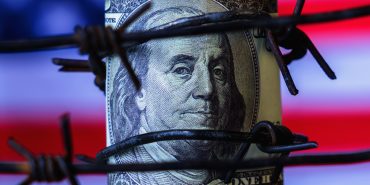
Global Manufacturers Retreat from US Market Amid Tariff Surge
6 minute read

US tariff hikes force international manufacturers to cancel expansion plans as stock markets tumble toward bear territory
Key Takeaways
- S&P 500 drops 12% in four trading days following Trump’s “Liberation Day” tariff announcement, with US stocks down 18% since inauguration and approaching bear market territory.
- US tariff rates surge from 2.5% to 22% with sweeping import charges including 104% on China and 20% on the EU, reaching the highest level since 1910 according to Fitch Ratings.
- British manufacturers abandon US expansion plans with only 4% expressing interest in establishing operations there, marking the first time the US has dropped out of the top three destinations in a decade.
Introduction
Global manufacturers and investors are executing a dramatic retreat from the US market following the implementation of sweeping tariffs that have triggered widespread market turmoil. The US has dropped out of the top three destinations for British manufacturers for the first time in a decade, with only 4% expressing interest in establishing operations there.
This shift represents a fundamental change in global trade patterns. British exports to the US plummeted by £2 billion in April, marking the largest monthly decline on record according to the Office for National Statistics. The tariff shock has created ripple effects across international markets, forcing companies to reassess their strategic positioning.
Key Developments
President Trump’s “Liberation Day” tariffs came into effect on April 9, implementing sweeping import charges on most countries worldwide. The measures include tariffs of 20% on the EU and 104% on China, alongside a 10% baseline tariff on most other imports.
The tariff structure targets countries with significant trade deficits with the US through escalating rates. China faces a 34% rate, Japan encounters 24%, while the EU confronts 20% charges. These measures have elevated the average US tariff rate from 2.5% last year to 22% currently.
According to MoneyWeek, the tariff implementation has disrupted ultra-efficient global supply chains similar to pandemic-era disruptions. The policy shift marks what analysts describe as the end of the post-World War II world economic order.
Market Impact
US markets have experienced severe volatility since the tariff announcement. The S&P 500 dropped 12% in the four trading days following the policy unveiling, bringing total losses to 18% since Trump’s inauguration. American stocks now sit on the cusp of their 13th bear market since 1950.
International markets have suffered parallel declines. Germany’s DAX fell 9% since Liberation Day, while the FTSE 100 dropped 8%. Asian markets faced particularly severe pressure, with exceptional volatility driving the VIX index to its highest level since the 2020 COVID crash.
The market turbulence reflects investor concerns about stagflation and potential recession. JPMorgan Chase analysts estimate a 60% probability of global recession this year, while trading volatility suggests tariff pain will be widely distributed across international markets.
Strategic Insights
The tariff implementation creates structural challenges for global supply chains, particularly affecting technology companies reliant on hardware and components from China and Taiwan. Many firms are exploring alternative suppliers, local sourcing, or shifting manufacturing to regions less affected by tariff policies.
Hardware costs are rising significantly, with products like Cisco 9000 Series routers experiencing price increases. Companies face difficult choices between absorbing costs, raising prices, or reengineering products to maintain competitiveness.
Despite these headwinds, sectors like AI and cloud infrastructure continue attracting substantial investment. The ongoing digital transformation and generative AI adoption provide growth opportunities for companies positioned to weather short-term disruption.
Expert Opinions and Data
“The post-World War II world economic order is finished,” says Reshma Kapadia in Barron’s, highlighting the fundamental shift in global trade architecture. The tariff measures represent the most significant trade policy change in over a century.
“Wall Street blew it,” argues James Surowiecki in The Atlantic, noting that investors displayed “wilful blindness” to Trump’s consistent trade beliefs spanning nearly 40 years. Trump’s conviction that “deficits are horrible, and tariffs are great” has remained remarkably consistent throughout his career.
Bill Dudley warns on Bloomberg that tariffs constitute a $600 billion tax increase on living costs that will harm consumers. He predicts US inflation will reach nearly 5% over coming months, reducing space for interest-rate cuts and potentially triggering stagflation or full recession.
Gartner forecasts worldwide IT spending at $5.75 trillion in 2025, representing a 9.3% increase over 2024. This growth is largely driven by cloud providers expanding data center capacity to meet AI demand, demonstrating continued sector momentum despite macroeconomic challenges.
Conclusion
The US market faces unprecedented challenges as tariff policies reshape global trade relationships and trigger significant market volatility. While companies are reassessing their exposure to American markets, the fundamental economic strengths of the US economy remain intact. The current disruption represents a critical inflection point that will determine future patterns of international commerce and investment flows.








